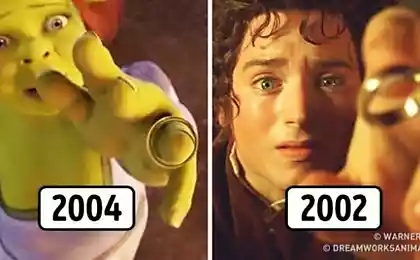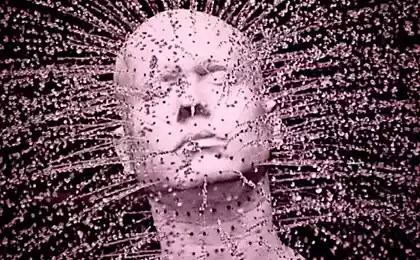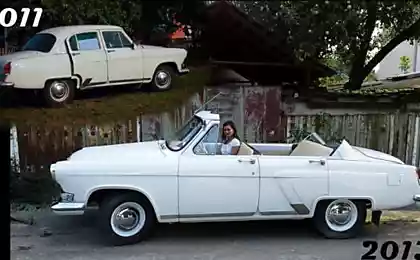1414
About plastic (7 pics + text)
Look around in his office, in the kitchen or in the bedroom, plastic surrounds us everywhere. Packaging of our food, clothing, computers, mobile phones, stationery and even baby toys - all made of plastic! In everyday life we do not even think, as the impact of these plastic products on our health, our children's health and the environment.
Some plastics are a direct threat to our health. So in the production of polycarbonate from which made some of our dishes, Bisphenol A is used, which, according to researchers of Western scholars, causing hormonal disorders, which ultimately leads to obesity, infertility, early puberty, greatly increases the likelihood of cancer.

Some plastic products, you can see the triangle, the walls of which form an arrow. In the center of this triangle is placed figure. This designation - sign recycling plastics which divides all seven groups to facilitate the further processing.
In everyday life, this icon can be defined for any purpose, you can use a plastic product, and in some cases even eliminate the use of this product.
1. Polyethylene terephthalate (PETE / PET)
The most common type of plastic. In bottles made from polyethylene terephthalate, various bottled soft drinks (juice, water), sunflower oil, ketchup, mayonnaise, cosmetics.
Advantages of plastic: low cost, durability, safety.
Disadvantages Plastics: low barrier properties (easily penetrate into the bottle ultraviolet and oxygen; carbon dioxide contained in soft drinks, is also relatively easy to seep through the wall).
Risks to health and the environment: Officially, polyethylene terephtalate bottles are safe for health. Nevertheless, there is information that the contents of the bottles can leach toxic antimony from the walls of the bottles (especially when heated). This information still requires validation. While PETE is considered one of the safest types of plastics. Yet doctors do not recommend reusing PETE-bottle, because at home they are easy to wash clean enough, "get rid" of all microorganisms.
Recycling: Recycling is done mechanically (grinding) and physico-chemically. Processing of the products can be fabricated into a wide variety of products, including plastic bottles again.
2. High Density Polyethylene (HDPE)
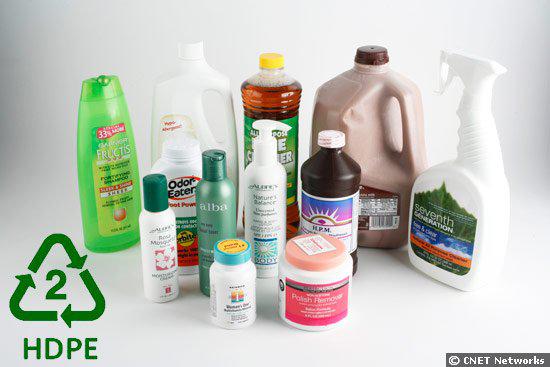
High density polyethylene bottles made shampoos, cosmetics and detergents, motor oil cans, disposable tableware, containers and containers for food, containers for freezing food, toys, various caps and lids for bottles and vials, durable shopping bags, packaging bags and boxes.
Advantages of plastic: low cost, safety, durability, ease of processing, resistant to oils, acids, alkalis and other aggressive media, HDPE-containers may be heat sterilized sufficiently high operational temperature range from -80 ° C to + 110 ° C
Disadvantages of plastics: - Risk to health and the environment: Despite the fact that the HDPE-products, as well as PETE-products are considered safe for human health, there are a number of myths, according to which of the walls of the container, can get into the liquid hexane and benzene . While this is only the myths that have no scientific evidence.
Recycling: HDPE-waste is crushed in special plants, then the granules are melted again in various products.
3. Polyvinyl chloride (PVC / V)
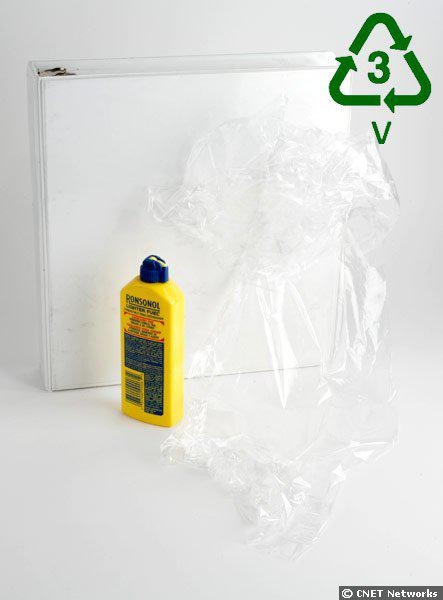
Polyvinyl chloride, also known as PVC, vinyl is used for production of linoleum, window profiles, the edges of furniture, packaging of household appliances, artificial leather, film for stretch ceiling, siding, pipe, wire and cable insulation, shower curtains, folders with metal rings, cheese wrappers and meat and vegetable oil bottles, and some toys.
Advantages of plastic: resistance to acids, alkalis, solvents and oils, gasoline, kerosene, a good insulator, does not burn.
Disadvantages of plastic: a small operating temperature range from -15 ° C to + 65 ° C, the difficulty in recycling, toxicity.
Risks to health and the environment: It is the most poisonous and dangerous to the health of the form of plastics. The combustion of PVC produced highly toxic organochlorine compounds, after 10 years of service products made of PVC, are beginning to self-released into the environment toxic organochlorines. The most annoying thing is that to give more flexibility PVC continue to use in the manufacture of toys. There is information that polyvinyl chloride enters the bloodstream and causes the human hormonal disorders that lead to early puberty and infertility.
Processing: injection molding, compression molding, extrusion, calendering.
4. Low Density Polyethylene (LDPE)
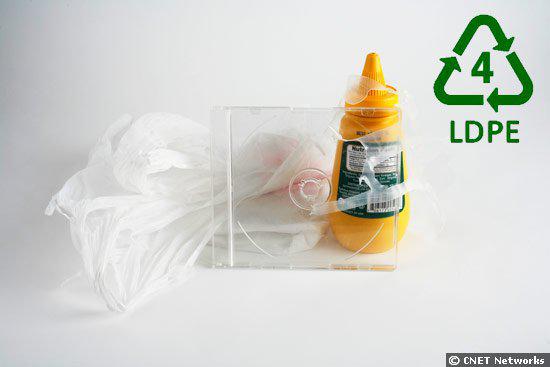
Low density polyethylene manufactured various packaging materials, bags for supermarkets, CD, DVD - drives
Advantages of plastic: cheapness, lightness.
Disadvantages of plastics: marginal processing.
Risks to health and the environment: officially considered harmless, despite the fact that the production of LDPE used potentially hazardous butane, benzene and vinyl acetate.
Processing: Processing of low-profit and reduced to the fragmentation of LDPE-product, followed by granulation. Mass production of LDPE leads "to cluttering" the environment. LDPE-bags littered the streets of cities and dump tons they swim in the seas and oceans, causing the death of fish, birds, sea turtles and other animals that choke and entangled in them. Many cities in the world to stop using plastic bags.
5. Polypropylene (PP)
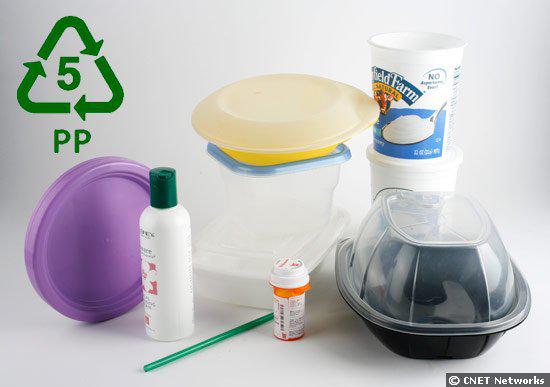
Made of polypropylene buckets, utensils for hot dishes, disposable syringes, bags of sugar, containers for freezing food, cover the majority of bottles, oiler, packing some food, construction is used for soundproofing. Many appliance manufacturers use polypropylene for packaging their products, giving up toxic PVC.
Advantages of plastic heat resistance (melting point 175 ° C), resistant to wear; more heat resistant than polyethylene.
Disadvantages Plastics: light sensitive and oxygen ages faster than the polyethylene; less hardy than polyethylene.
Risks to health and the environment: It is believed that polypropylene is safe for health. Recently, a group of Japanese scientists found that small particles of polypropylene floating in the ocean waters absorb various toxicants, dissolved in seawater, such as DDT and PCBs.
Processing: injection molding, compression molding, extrusion.
6. Polystyrene (PS)
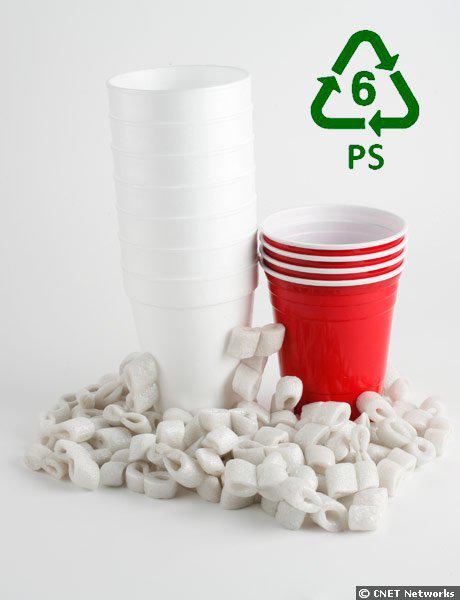
Made of polystyrene disposable tableware, containers for food, yogurt cups, toys, insulating panels, sandwich panels, ceiling moldings, ceiling decorative tiles, packaging trays for food in supermarkets (meat, various nuts, etc.), packaging egg boxes.
Advantages of plastic: cheapness, frost resistance, ease of processing, a good insulator.
Disadvantages of plastic: low mechanical strength and chemical instability.
Risks to health and the environment: the previously obtained polystyrene was associated with the release of trichlorofluoromethane (Freon), which deplete the ozone layer of the Earth. Polystyrene obtained by polymerizing styrene, which is carcinogenic.
Recycling: extrusion followed by crushing and granulation.
7. Other plastics
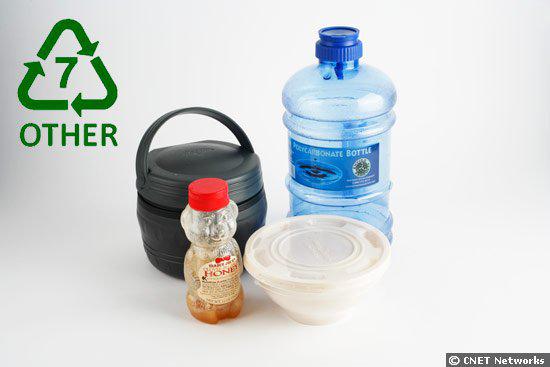
Risks to health and the environment: A group that includes other types of plastic, so use them in everyday life can be fraught with danger to your health. So polycarbonate from which made some dishes for food and bottles in contact with hot liquids can release Bisfinol A, which can cause various hormonal disorders in humans (early puberty, obesity, cancer, ...). However, this group may also include environmentally friendly plastics that biodegrade in the environment involving microorganisms. That is buying container from this group of plastics you play roulette.
Recycling: do not.
Get more information about the different types of plastic you can on Wikipedia.
In conclusion, we want to give a few tips:
- If possible, give up plastic utensils in favor of wood, glass, porcelain, metal (instead of plastic cutting board to use wooden, plastic bottle in the campaign can be replaced with a metal flask).
Some manufacturers (Klean Kanteen, Sigg, Timolino) now produce bottles instead of plastic bottles reusable stainless steel.
Source
Some plastics are a direct threat to our health. So in the production of polycarbonate from which made some of our dishes, Bisphenol A is used, which, according to researchers of Western scholars, causing hormonal disorders, which ultimately leads to obesity, infertility, early puberty, greatly increases the likelihood of cancer.

Some plastic products, you can see the triangle, the walls of which form an arrow. In the center of this triangle is placed figure. This designation - sign recycling plastics which divides all seven groups to facilitate the further processing.
In everyday life, this icon can be defined for any purpose, you can use a plastic product, and in some cases even eliminate the use of this product.
1. Polyethylene terephthalate (PETE / PET)
The most common type of plastic. In bottles made from polyethylene terephthalate, various bottled soft drinks (juice, water), sunflower oil, ketchup, mayonnaise, cosmetics.
Advantages of plastic: low cost, durability, safety.
Disadvantages Plastics: low barrier properties (easily penetrate into the bottle ultraviolet and oxygen; carbon dioxide contained in soft drinks, is also relatively easy to seep through the wall).
Risks to health and the environment: Officially, polyethylene terephtalate bottles are safe for health. Nevertheless, there is information that the contents of the bottles can leach toxic antimony from the walls of the bottles (especially when heated). This information still requires validation. While PETE is considered one of the safest types of plastics. Yet doctors do not recommend reusing PETE-bottle, because at home they are easy to wash clean enough, "get rid" of all microorganisms.
Recycling: Recycling is done mechanically (grinding) and physico-chemically. Processing of the products can be fabricated into a wide variety of products, including plastic bottles again.
2. High Density Polyethylene (HDPE)

High density polyethylene bottles made shampoos, cosmetics and detergents, motor oil cans, disposable tableware, containers and containers for food, containers for freezing food, toys, various caps and lids for bottles and vials, durable shopping bags, packaging bags and boxes.
Advantages of plastic: low cost, safety, durability, ease of processing, resistant to oils, acids, alkalis and other aggressive media, HDPE-containers may be heat sterilized sufficiently high operational temperature range from -80 ° C to + 110 ° C
Disadvantages of plastics: - Risk to health and the environment: Despite the fact that the HDPE-products, as well as PETE-products are considered safe for human health, there are a number of myths, according to which of the walls of the container, can get into the liquid hexane and benzene . While this is only the myths that have no scientific evidence.
Recycling: HDPE-waste is crushed in special plants, then the granules are melted again in various products.
3. Polyvinyl chloride (PVC / V)

Polyvinyl chloride, also known as PVC, vinyl is used for production of linoleum, window profiles, the edges of furniture, packaging of household appliances, artificial leather, film for stretch ceiling, siding, pipe, wire and cable insulation, shower curtains, folders with metal rings, cheese wrappers and meat and vegetable oil bottles, and some toys.
Advantages of plastic: resistance to acids, alkalis, solvents and oils, gasoline, kerosene, a good insulator, does not burn.
Disadvantages of plastic: a small operating temperature range from -15 ° C to + 65 ° C, the difficulty in recycling, toxicity.
Risks to health and the environment: It is the most poisonous and dangerous to the health of the form of plastics. The combustion of PVC produced highly toxic organochlorine compounds, after 10 years of service products made of PVC, are beginning to self-released into the environment toxic organochlorines. The most annoying thing is that to give more flexibility PVC continue to use in the manufacture of toys. There is information that polyvinyl chloride enters the bloodstream and causes the human hormonal disorders that lead to early puberty and infertility.
Processing: injection molding, compression molding, extrusion, calendering.
4. Low Density Polyethylene (LDPE)

Low density polyethylene manufactured various packaging materials, bags for supermarkets, CD, DVD - drives
Advantages of plastic: cheapness, lightness.
Disadvantages of plastics: marginal processing.
Risks to health and the environment: officially considered harmless, despite the fact that the production of LDPE used potentially hazardous butane, benzene and vinyl acetate.
Processing: Processing of low-profit and reduced to the fragmentation of LDPE-product, followed by granulation. Mass production of LDPE leads "to cluttering" the environment. LDPE-bags littered the streets of cities and dump tons they swim in the seas and oceans, causing the death of fish, birds, sea turtles and other animals that choke and entangled in them. Many cities in the world to stop using plastic bags.
5. Polypropylene (PP)

Made of polypropylene buckets, utensils for hot dishes, disposable syringes, bags of sugar, containers for freezing food, cover the majority of bottles, oiler, packing some food, construction is used for soundproofing. Many appliance manufacturers use polypropylene for packaging their products, giving up toxic PVC.
Advantages of plastic heat resistance (melting point 175 ° C), resistant to wear; more heat resistant than polyethylene.
Disadvantages Plastics: light sensitive and oxygen ages faster than the polyethylene; less hardy than polyethylene.
Risks to health and the environment: It is believed that polypropylene is safe for health. Recently, a group of Japanese scientists found that small particles of polypropylene floating in the ocean waters absorb various toxicants, dissolved in seawater, such as DDT and PCBs.
Processing: injection molding, compression molding, extrusion.
6. Polystyrene (PS)

Made of polystyrene disposable tableware, containers for food, yogurt cups, toys, insulating panels, sandwich panels, ceiling moldings, ceiling decorative tiles, packaging trays for food in supermarkets (meat, various nuts, etc.), packaging egg boxes.
Advantages of plastic: cheapness, frost resistance, ease of processing, a good insulator.
Disadvantages of plastic: low mechanical strength and chemical instability.
Risks to health and the environment: the previously obtained polystyrene was associated with the release of trichlorofluoromethane (Freon), which deplete the ozone layer of the Earth. Polystyrene obtained by polymerizing styrene, which is carcinogenic.
Recycling: extrusion followed by crushing and granulation.
7. Other plastics

Risks to health and the environment: A group that includes other types of plastic, so use them in everyday life can be fraught with danger to your health. So polycarbonate from which made some dishes for food and bottles in contact with hot liquids can release Bisfinol A, which can cause various hormonal disorders in humans (early puberty, obesity, cancer, ...). However, this group may also include environmentally friendly plastics that biodegrade in the environment involving microorganisms. That is buying container from this group of plastics you play roulette.
Recycling: do not.
Get more information about the different types of plastic you can on Wikipedia.
In conclusion, we want to give a few tips:
- If possible, give up plastic utensils in favor of wood, glass, porcelain, metal (instead of plastic cutting board to use wooden, plastic bottle in the campaign can be replaced with a metal flask).
Some manufacturers (Klean Kanteen, Sigg, Timolino) now produce bottles instead of plastic bottles reusable stainless steel.
Source



